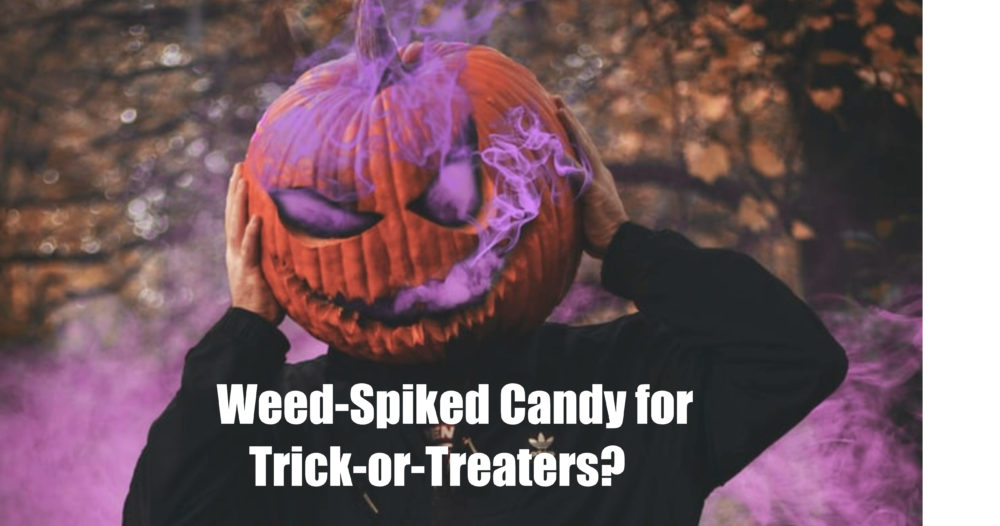Fast Weed Delivery

Weed Lore 2: Marijuana In Your Kid’s Halloween Candy
If you’re an American born in the 1970s or 80s like me, there’s a good chance you’ve received a healthy dose of Halloween candy fear mongering. Our parents and teachers warned us of nefarious strangers looking for creative ways to deceive unsuspecting children into ingesting illicit or dangerous substances. This myth was especially prevalent around this time of year, when trick-or-treaters will soon be collecting candy from neighbors. From my perspective, it seemed common knowledge to the adults in my life that all Halloween candy had to be checked by adults before we kids could eat it.
I remember a few different versions of this myth. One involved strangers poisoning kids with chemicals, while another held that there could be razors planted in the candy. Still another, and in my opinion the most absurd, was a grand old Nancy Reagan gem: drug dealers were spiking candy with addictive drugs in order to get kids hooked so that they could have new buyers for their products.
As completely laughable as it is to instill this myth in a child’s brain, it’s even more hilarious to me to think that these seemingly smart, responsible adults, believed and recited this belief without a drop of irony. And even more ridiculous is that in the 1980s, many people didn’t differentiate between marijuana and harmful, addictive drugs like cocaine or heroin.
All this got us thinking: Where did this fear originate? Have kids really been intentionally given marijuana or other substances in their Halloween candy?
Halloween Sadism
Believe it or not, there’s actually a term for the practice of giving contaminated treats to trick-or-treaters: Halloween sadism. And believe it or not, there is an expert on the subject. His name is Joel Best, and he’s been studying Halloween sadism since 1985 (shout out to Nancy Reagan). It was in 1985 that Best published an article about the press coverage of Halloween sadism. He searched for reports of specific incidences, reporting on where the incident occurred and how the treat had been contaminated.
Despite widespread belief in pervasive acts of Halloween sadism and despite media articles each year encouraging parents to screen their kids’ candy before eating, Best has been unable to find a single substantiated report of a child being killed or injured by a contaminated treat received in the course of trick-or-treating. In fact, in each case Best has come across involving an injured or killed child, follow-up reports have found that the child either died from natural causes, an accident, or was intentionally harmed by someone close to them. Stranger danger was never the problem. “I can never prove that no child has been killed by a Halloween sadist,” Best writes. “I can simply note that such a death probably would be a major news story, yet I can’t find any evidence of such a story being covered by major media.”
Marijuana Myth & the Legend
So if there is no evidence that Halloween sadism actually exists, where did the idea come from? The earliest known report of Halloween sadism occurred on Long Island in 1964. A housewife who was later hospitalized for psychiatric treatment, handed out steel wool, dog biscuits, and ant poison to kids she thought were too old to be trick-or-treating. And although this incident seems to have sparked the growth of the urban legend, there is no evidence that she was trying to disguise the poison as candy or intended anyone to eat it. It seems she intended it more like Santa putting coal in the stocking of a naughty kid.
By the 1970s, the legend seems to have taken hold in the American consciousness, and incidents that were even closely related to Halloween sadism only added fuel to the fire. For instance, 10 years after the Long Island incident, a father in Pasadena, Texas poisoned his son’s Halloween candy, and the boy died. It later turned out the father had purchased a life insurance policy. He was later executed for his son’s murder.
Incidents such as these have fed the myth, but reports always point out that – no, strangers are not contaminating your kid’s Halloween candy.
The Cannabis Link
Times and attitudes have changed quite a bit since Nancy Reagan told us to Just say no. These days, it seems most Americans have developed a different view on cannabis and its use. Much of the fear around cannabis in our culture has subsided. That said, there remain persistent notions from both the community and even law enforcement that THC-laced candies are circulating in the Halloween candy given out to kids.
Even beyond intentional sadism, some parents are concerned their kids will be given legal THC-infused candies by mistake. This is made highly unlikely by the fact that regulations mandate THC candies to not resemble fruit, animals, or even humans. And as Jane C. Hu wrote for Slate, “It goes without saying that yes, it’s good to remain vigilant on Halloween. The same common sense rules about what not to eat on any other day of the year also applies to trick-or-treat spoils: Don’t eat random pieces of unwrapped candy or anything else that seems off to you. But rest assured that, even in this age of weed-infused gummies, it’s incredibly unlikely kids are going to end up with marijuana candy. Because why would adults give away their marijuana over consuming it themselves?”
The moral of the story here is: no one likes your kids enough to share weed with them. Take normal, reasonable precautions, and make sure to dispel these myths wherever possible.

